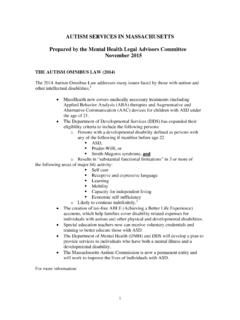Transcription of RIGHTS REGARDING INVOLUNTARY CIVIL …
1 1 RIGHTS REGARDING INVOLUNTARY CIVIL commitment FOR TREATMENT OF AN ALCOHOL AND SUBSTANCE USE DISORDER IN MASSACHUSETTS Prepared by the Mental Health Legal Advisors Committee August 2018 What is Massachusetts General Law Chapter 123, Section 35? Section 35 is a Massachusetts law that allows a person to request a court order requiring someone to be civilly committed and treated involuntarily for an alcohol or substance use Who can petition the court for a Section 35 commitment ? The following people can petition the court to request a Section 35 CIVIL commitment for someone: Police officer; Physician; Spouse; Blood relative; Guardian; Court How does the commitment process work?
2 A petition for CIVIL commitment under Section 35 can be filed at any district court or juvenile court. Once the court receives a petition for commitment , if there are reasonable grounds to believe the person subject to the petition won t appear voluntarily for a hearing, and that further delay would present an immediate physical danger to the person, a judge may issue a warrant for that person. This means that police officers will attempt to locate the person, take the person into custody, and deliver the person to the court for a commitment hearing. The warrant is valid for up to five consecutive days, excluding Saturdays, Sundays, and legal holidays, or until such time as the person goes to court, whichever is sooner.
3 If a judge does not issue a warrant for the person, the person subject to the petition will receive a summons, which is an order to appear in court before a The person has the right to be represented by an attorney. If the court finds that the person is too poor to afford a lawyer, the court will immediately appoint an attorney for the At the court hearing, the court shall order examination by a qualified physician, psychologist or social The person has a right to refuse the examination. The person s attorney may present independent expert testimony or other testimony from family, friends, employers and others concerned.
4 6 2 After testimony and argument, the judge will decide if there is clear and convincing evidence that: The person has an alcohol or substance use disorder; and There is a likelihood of serious harm as a result of that disorder. If both criteria are met, the person will be involuntarily committed. If one (or both) criteria are not met, the person will be A judge should order a commitment under Section 35 only when less restrictive alternatives are What happens if the court orders the person to be civilly committed under Section 35? An order may require that the person submit to treatment for up to 90 Where may a person be civilly committed to?
5 The court may only commit the person to a facility designated by the state Department of Public Health (DPH).10 The facility must be licensed or approved by DPH or the state Department of Mental Health (DMH) for the treatment of an alcohol or substance use A list of facilities that currently treat persons under Section 35 is available in a state Department of Health and Human Services publication, Section 35 FAQ about CIVIL commitment of those with Substance Abuse problems and other Options, available at If these facilities are full and cannot accept more patients, or if the court makes a specific finding that the only appropriate setting for treatment for the person is a secure facility.
6 Then the court may commit a man to the Massachusetts correctional institution at Bridgewater , or any other correctional facility approved by the Commissioner of the state Department of Correction (DOC), or a woman to a secure facility for women approved by DPH or (Women can no longer be committed to MCI Framingham or any other correctional facility.) If committed to a correctional facility, the person must be housed and treated separately from persons serving a criminal What services should a person committed pursuant to Section 35 receive? Treatment consists of an assessment of the person s need for detoxification and rehabilitation.
7 If necessary, the person is provided detoxification treatment. In rehabilitation, the person learns more about addiction, how to stay sober, and how to prevent relapse. Counselors encourage the person to engage in aftercare treatment services and 3 What other RIGHTS does a person have under Section 35? A person s need for commitment must be reviewed by the facility s superintendent on days 30, 45, 60, and 75 as long as the commitment A person can be released prior to the expiration of the commitment period if the superintendent of the facility states in writing that releasing the person will not likely result in serious Upon release, the person will have access to further treatment.
8 Including the option to remain at the facility DPH-licensed facilities If the person is committed pursuant to Section 35 to a facility licensed by DPH, certain of DPH regulations within 105 CMR 164 apply. RIGHTS pursuant to applicable regulations include: The right to an individualized treatment The right to at least four hours of treatment per The right to a written discharge summary including any appropriate referrals, supports and services available to the client after discharge, and an aftercare and follow-up plan. 20 The right to be free from strip searches, body cavity searches, or similar DMH-operated units or facilities If the person is committed pursuant to Section 35 to a facility or unit within a facility operated by DMH, DMH regulations 104 CMR RIGHTS pursuant to those regulations include: The right to space that is safe, comfortable, well-lit, well-ventilated, adequate in size and of sufficient quality to allow for treatment.
9 23 The right to treatment upon giving informed consent, or if the person is incapable of providing informed consent, the right to treatment as authorized by a guardian or health care agent. Prior to an adjudication of incapacity and appointment of a guardian, or activation of a health care proxy, the person retains the right to accept or refuse medications as The RIGHTS set forth in DMH regulation 104 CMR , such as the right to telephone, mail, visits, access to an attorney or legal advocate, daily access to the The human right to have drug screens conducted in a manner that preserves the person s The right to safeguards to protect RIGHTS .
10 Including through the right to the assistance of a facility human RIGHTS officer and human RIGHTS The right to protections REGARDING the use of restraint and seclusion as provided in DMH regulation, 104 CMR 28 The right to make a complaint REGARDING any incident or condition which the person believes to be dangerous, illegal or inhumane as those terms are defined in DMH regulation, 104 CMR 29 4 The right to competent interpreter services for non-English speaking patients in accordance with the requirements of DMH regulation, 104 CMR 30 The right, upon discharge, to a post-discharge treatment plan with identified resources for further treatment.






